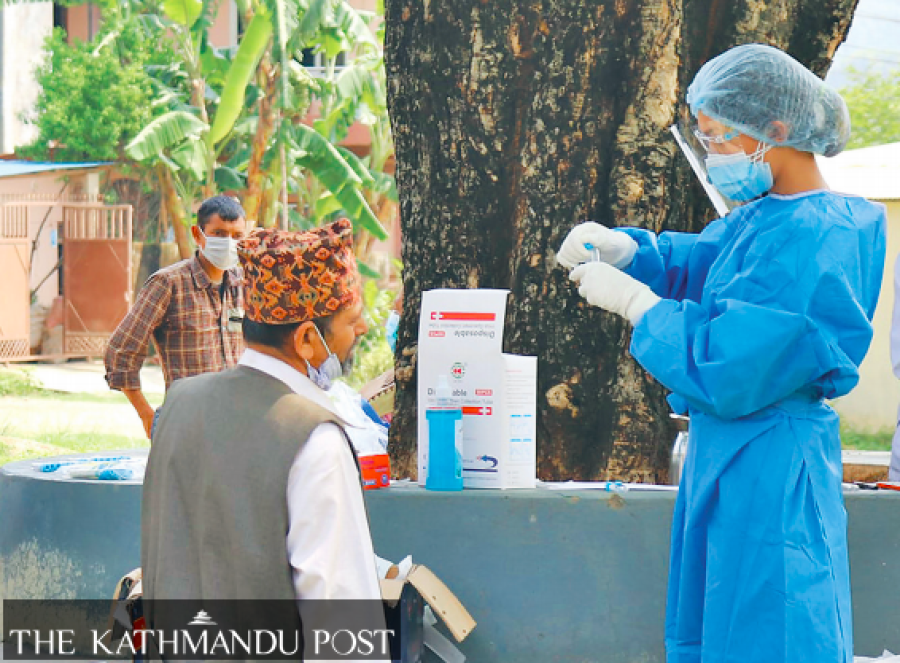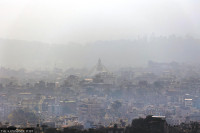Health
Even after high positivity rates in some districts, testing has not been ramped up
In a first during the second wave, Kathmandu does not record most infections on a single day, raising fears that the virus could be spreading more elsewhere.
Arjun Poudel
On Saturday, Nepal reported 1,688 new coronavirus infections, the second lowest one day figure since April 20. On Tuesday, June 15 1,681 new infections were reported.
But on Saturday, for the first time during the ongoing second wave of the pandemic that began in mid-April, a district other than Kathmandu reported the highest number of cases on a single day.
While 201 new cases were reported in Kathmandu on Saturday, the figure was 225 for Baglung.
“We cannot reach a conclusion that there has been a decline in new cases all over the country on the basis of the report of the polymerase chain reaction tests alone,” Dr Achyut Raj Karki, the Covid-19 focal person at Bir Hospital, told the Post.
From a high of 9,317 cases on May 11, the daily number of total cases in the country have been coming down gradually.
But this is also because the number of tests are coming down, according to doctors. From 22,353 PCR tests on May 21, test numbers have been declining and 7,010 were reported on Saturday.
“When we increase testing, the number of infected people also increases,” said Karki. “High number of positivity in certain districts means people are still getting infected and the virus has been spreading in communities.”
According to data from the Ministry of Health and Population, between June 16 and 19, a total of 1,703 polymerase chain reaction tests were conducted at Dhaulagiri Hospital in Baglung. Of these 964 returned positive, a positivity rate of almost 57 percent.
Government data shows that there were no tests conducted at the hospital on the days preceding June 16.
The positivity rate for the whole country for these four days in contrast was 24 percent.
The test positivity rate has been high in other hospitals across the country too.
Of the 1,133 polymerase chain reaction tests performed at Trishuli Hospital from June 13 to 19, 502 people tested positive for the coronavirus—a test positivity rate of over 44 percent.
The national test positivity during the same period was 24 percent.
Swab samples tested at Trishuli Hospital are collected from Nuwakot, Rasuwa and Dhading districts, meaning that the number of infections continues to increase in these districts.
“All the intensive care unit beds, high dependency unit beds and ventilators have been occupied by the seriously ailing patients,” Dr Kripa Maharjan, Covid-19 focal person at Trishuli Hospital, told the Post, over the phone from Nuwakot. “I don’t know how the national positivity rate has declined, but in the three districts, two of which border the Capital, the positivity rates are still very high.”
The hospital has 12 intensive care unit beds, eight high dependency unit beds and seven ventilators.
At Mechi Hospital, 1,586 polymerase chain reaction tests were conducted in the past one week. Of these 627 returned positive—a test positivity rate of almost 40 percent.
Similarly, at the two testing centres in Surkhet and Jumla in Karnali Province, 644 swab samples were tested in the past week and 238 of them tested positive. The positivity rate is almost 37 percent, the highest of the seven provinces.
Overall, the number of cases may be going down nationwide but in some parts of the country the number of positive cases continues to grow.
According to Karki, data on who exactly are being tested should also be made available as there may be a lot of people who are having their swabs tested voluntarily to know their infection status rather than because they have been in contact with infected and likely to be infected themselves.
This could be why the overall positivity rate might have come down, he said.
In the past one week, based on polymerase chain reaction tests, Province 1 has 29 percent positivity rate, Province 2 has 18 percent Bagmati Province has 22 percent, Gandaki Province 37, Lumbini Province has 19 percent, Karnali Province 37 and Sudur Paschim has 9 percent positivity rate.
“We should also keep in mind that if the swab samples were collected from major hotspots and the positivity rate has declined, it can be said it is the lockdown effect,” said Karki.
Lockdowns in cities have been enforced better than in villages where the number of cases are rising.
Although the nationwide case positivity rate which had at one point crossed 50 percent declined to around 24 percent on Saturday, doctors say that it is still too high.
“Twenty-four percent positive rate is too high, which demands a threefold increase in PCR tests,” Dr Santa Kumar Das, the coordinator of the Covid-19 Management Committee at the Tribhuvan University Teaching Hospital told the Post. “We must detect active cases and for this sample collection should be ramped up in communities.”
According to Das, for the restrictive measures to be loosened up the case positivity rate should be brought down to less than five percent. The World Health Organisation also said that the percent positivity rate should be less than five percent to relax social restrictions.
On Monday, the positivity rate had declined to 0.22 percent in the capital city of India, which witnessed the worst coronavirus outbreak earlier.
When asked why the number of tests have not been increased in the districts, which have high positivity rates, Dr Samir Kumar Adhikari, joint spokesperson at the Health Ministry, said that antigen tests are being conducted in those districts.
The number of antigen tests are being ramped up across the country, mostly in rural areas that do not have laboratories for PCR tests, in recent weeks from less than 500 to about 5,000.
The Health Ministry on Saturday said 4,686 antigen-based tests were performed in the last 24 hours of which 713 were positive.
Karki said that it will be too early to conclude that the transmission chain of the virus has broken and without analysing all test data of both polymerase chain reaction tests and antigen tests.
Meanwhile, Health Ministry officials concede that risk of infection has not declined and even if nationwide positivity rate has declined, some districts still have high positivity rates, which means the virus is still spreading in communities.
“Covid-19 infection keeps spreading in communities if measures to break the transmission are not taken and cases will explode after a certain period like in the past,’ said Das of the Tribhuvan University Teaching Hospital.
But for tracing, testing, isolating have to be carried out at a massive scale to prevent such an explosion. And antigen testing is not the answer, according to doctors.
“PCR tests should be increased, as antigen-based tests are not as reliable as PCR tests,” said Das. “A lot of infected people could be missed in antigen tests and they could be the source for transmission of the virus.”




 8.12°C Kathmandu
8.12°C Kathmandu













%20(1).jpg&w=300&height=200)
